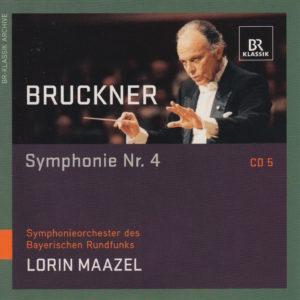 This morning’s conductor of Anton Bruckner’s Symphony No. 4 in E Flat Major (WAB 104), titled “Romantic” by Bruckner himself, is American Lorin Maazel (1930-2014), a person about whom I knew nothing and, in fact, of whom I had never heard until I started this 144-day project.
This morning’s conductor of Anton Bruckner’s Symphony No. 4 in E Flat Major (WAB 104), titled “Romantic” by Bruckner himself, is American Lorin Maazel (1930-2014), a person about whom I knew nothing and, in fact, of whom I had never heard until I started this 144-day project.
I encountered Mr. Maazel three times previously: On Day 9, Day 25, and Day 41.
To say that Mr. Maazel has not been one of my favorites is to understate the matter.
 But before I get too subjective about this morning’s recording, here are the nuts and bolts:
But before I get too subjective about this morning’s recording, here are the nuts and bolts:
Bruckner’s Symphony No. 4 in E Flat Major composed in 1874
Lorin Maazel conducts
Maazel used the 1878/1880 version, edited by Nowak
Symphonieorchester des Bayerischen Rundfunks plays
The symphony clocks in 73:34 (Yikes!)
This was recorded in Munich, Germany, in either February or June of 1999 (the date is listed as 06.02.1999 – so is this an American format and it’s June 2? Or a European format and it’s February 6?)
Maazel was 67 when he conducted it
Bruckner was 50 when he composed it
This recording was released on the BR Klassik Label
Of the 1878/1880 version, its entry on Wikipedia tells us this:
1880 version (aka 1878/1880)
After the lapse of almost a year (during which he composed his String Quintet in F Major), Bruckner took up his Fourth Symphony once again. Between 19 November 1879 and 5 June 1880 he composed a new finale – the third, though it shares much of its thematic material with the first version – and discarded the Volksfest finale. Thus the 1880 version is the same as the 1878 version but with a new finale. This was the version performed at the work’s premiere on 20 February 1881, which was the first premiere of a Bruckner symphony not to be conducted by Bruckner himself. This version is sometimes referred to as the 1878/80 version.
Bruckner wrote his symphonies in four parts. The time breakdown of this one (Symphony No. 4 in E Flat Major, 1878/1880 version, ed. by Haas), from this particular conductor (Maazel) and this particular orchestra (Symphonieorchester des Bayerischen Rundfunks) is as follows:
I. Bewegt, nicht zu schnell (With motion, not too fast) (E-flat major)…………..21:27
II. Andante, quasi allegretto (C minor)…………………………………………………………..16:13
III. Scherzo. Bewegt (With motion) – Trio: Nicht zu schnell (Not too fast) (B-flat major)……………………………………………………………………………………………………………..11:54
IV. Finale: Bewegt, doch nicht zu schnell (With motion, but not too fast) (E-flat major)………………………………………………………………………………………………………………23:58
Total running time: 73:34 (another Yikes! award for length)
Okay. Now for the subjective stuff…
My Rating:
Recording quality: 3
Overall musicianship: 3
CD liner notes: 3 (short – but interesting – essays on Bruckner, Maazel, and the orchestra, translated into German and English; however, virtually nothing about the recordings – like when? where? what year? that information is on the CD sleeve)
How does this make me feel: 3 (veeerrrryyyy sleepyyyyyy Zzzzzzz)
Someone needs to explain to me how this interpretation of Bruckner’s Fourth, using the same version that other conductors did, can be nearly 10 minutes longer than everyone else’s (except for Sanderling’s on Day 51; even then, Maazel’s interpretation is still nearly five minutes longer than Sanderling’s).
Why are Maazel’s interpretations always so bloated? What is he doing that the others aren’t?
Or is this a matter of tempo? Because this recording sure does seem to be lethargic. Some of these movements lack spark, magic, pizzazz, energy. The whole thing feels slower to me.
I’ve heard enough interpretations of Symphony No. 4 in E Flat Major to know that I’m supposed to be electrified by this music. It’s supposed to reach out and slap me in the face, wake me up, stir me.
This performance is the musical equivalent of walking through chest-deep water.
